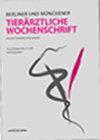Time pattern and causes of lamb mortality on commercial sheep farms in Southern Germany operating conservation grazing and non-seasonal production systems – a field study
IF 0.6
4区 农林科学
Q4 VETERINARY SCIENCES
Berliner und Munchener tierarztliche Wochenschrift
Pub Date : 2018-10-23
DOI:10.2376/0005-9366-18006
引用次数: 4
Abstract
Benchmarking is becoming increasingly important in sheep farming and little published data has so far been available for German sheep flocks. This field study was conducted to gather detailed information on lamb mortality on 17 large commercial sheep farms operating non-seasonal production systems in Southern Germany thus providing benchmarking data for this management system for the first time. During a twelve-month-period detailed lambing and mortality records were kept and suspected causes of death were noted by the farmers. Farm management data were obtained by questionnaire and statistical analyses were performed to identify potential influences on lamb mortality. A total of 14,918 lambs were born at term during the study period (13,751 alive and 1,167 stillborn). Abortion events were also noted, but insufficient records were kept on the number of aborted fetuses – these figures therefore only refer to lambs born at term. The mean stillbirth rate was 7.7% (range: 2.7–16.3%, median 7.2%, SD 3.6) while the average mortality of live-born lambs was 13.4% (range: 0.8–40.1%, median 11%, SD 9.8), leading to average total lamb losses of 20.1% (range 6.5–44.9%, median 17.7%, SD: 10.1). Perinatal deaths (stillbirth and lambs that died on their first day of life) accounted for an average of 52% of these total lamb losses (range: 33−89%, median 46%, SD: 16). Stillbirth was the predominant cause of lamb loss accounting for an average of 45% of deaths (range: 15−84%, median: 37%, SD: 18). Other suspected causes of death included infectious diseases (13%), maternal factors (8%), weakness (7%), accidents/external circumstances (4%), Schmallenberg Virus−related malformations (2%), parasites (2%), nutritional causes (2%) and other individual (1%) or unknown causes (16%). For our study population, farmer education was identified as a statistically significant factor related to a lower stillbirth rate. Fixed lambing times as opposed to year-round lambing showed a tendency to be associated with increased lamb survival, as did vaccination of the ewes against clostridial diseases and pasteurellosis. Multiples showed significantly higher peri- and neonatal mortality, while mortality of single lambs was significantly higher later in the rearing period. No statistically significant differences in lamb mortality could be shown for indoor versus outdoor lambing or other management factors. This study generated benchmarking data for flocks used in conservation grazing and non-seasonal production. The analysis of lambing data also proved very helpful on each individual farm to develop tailor-made flock health programmes and to identify farm-specific problems, particularly on farms with high mortality rates.德国南部经营保护性放牧和非季节性生产系统的商业绵羊养殖场羔羊死亡率的时间模式和原因-一项实地研究
标杆管理在绵羊养殖中变得越来越重要,迄今为止,关于德国羊群的公开数据很少。该实地研究旨在收集德国南部17个运营非季节性生产系统的大型商业绵羊养殖场羔羊死亡率的详细信息,从而首次为该管理系统提供基准数据。在12个月期间,详细保存了产羔和死亡率记录,并由农民记录了可疑的死亡原因。通过问卷调查和统计分析获得农场管理数据,以确定对羔羊死亡率的潜在影响。在研究期间,共有14918只羔羊足月出生(13751只活羊和1167只死胎)。堕胎事件也被记录了下来,但是对流产胎儿的数量没有足够的记录——因此这些数字只指足月出生的羔羊。平均死产率为7.7%(范围:2.7-16.3%,中位数为7.2%,SD为3.6),活产羔羊平均死亡率为13.4%(范围:0.8-40.1%,中位数为11%,SD为9.8),导致羔羊平均总损失20.1%(范围:6.5-44.9%,中位数为17.7%,SD: 10.1)。围产期死亡(死产和出生第一天死亡的羔羊)平均占羔羊总死亡的52%(范围:33 - 89%,中位数46%,标准差:16)。死产是羔羊死亡的主要原因,平均占死亡总数的45%(范围:15 - 84%,中位数:37%,标准差:18)。其他疑似死亡原因包括传染病(13%)、母体因素(8%)、虚弱(7%)、事故/外部环境(4%)、施马伦贝格病毒相关畸形(2%)、寄生虫(2%)、营养原因(2%)和其他个人原因(1%)或未知原因(16%)。对于我们的研究人群,农民教育被确定为与较低死产率相关的统计显著因素。固定的产羔时间与全年产羔相比,显示出与羔羊存活率增加有关的趋势,就像母羊接种抗梭菌病和巴氏杆菌病的疫苗一样。多羔的围产期和新生儿死亡率显著高于羔羊,而单羔的死亡率在饲养后期显著高于羔羊。在室内和室外产羔或其他管理因素中,羔羊死亡率没有统计学上的显著差异。这项研究为用于保护性放牧和非季节性生产的畜群提供了基准数据。对产羔数据的分析也证明对每个农场非常有帮助,有助于制定量身定制的羊群卫生方案,并确定农场特有的问题,特别是在死亡率高的农场。
本文章由计算机程序翻译,如有差异,请以英文原文为准。
求助全文
约1分钟内获得全文
求助全文
来源期刊
CiteScore
0.90
自引率
0.00%
发文量
0
审稿时长
18-36 weeks
期刊介绍:
The Berliner und Münchener Tierärztliche Wochenschrift is an open access, peer-reviewed journal that publishes contributions on all aspects of veterinary public health and its related subjects, such as epidemiology, bacteriology, virology, pathology, immunology, parasitology, and mycology. The journal publishes original research papers, review articles, case studies and short communications on farm animals, companion animals, equines, wild animals and laboratory animals. In addition, the editors regularly commission special issues on topics of major importance. The journal’s articles are published either in German or English and always include an abstract in the other language.

 求助内容:
求助内容: 应助结果提醒方式:
应助结果提醒方式:


